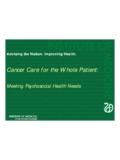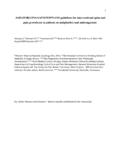Transcription of Psychosocial risk factors: what are they and why …
1 Ref 04-2015 v2 Psychosocial risk factors : what are they and why are they important? Wellnomics White Paper Dr Kevin Taylor (BE, PhD), Nicola Green, MPhil (Hons); BA (Business Psychology); Adv. Cert. Occ. Health Physio; Dip. Physio 2015 Wellnomics Ltd 2 Contents Introduction .. 3 what are Psychosocial risk factors ? .. 3 Why are Psychosocial risk factors important? .. 4 what evidence is there that Psychosocial risk factors influence musculoskeletal disorders? .. 4 How do Psychosocial risk factors contribute to musculoskeletal disorders? .. 5 Do Psychosocial risk factors have an impact on productivity? .. 6 what can be done about Psychosocial risk factors ? .. 6 7 Implications for organisations .. 7 References .. 8 3 Introduction There are many factors contributing to musculoskeletal discomfort and disorders in the workplace. The risk factors that have been associated with musculoskeletal problems are physical (such as awkward or prolonged postures) and individual (such as level of physical fitness or gender1 and Psychosocial ).
2 All risk factors need to be considered and addressed in order for organisations to prevent and manage these problems successfully. Important Psychosocial risk factors are included in the Wellnomics Work Environment assessment. what are Psychosocial risk factors ? Psychosocial risk factors are associated with the way individuals interact with the demands of their job and their work environment. This includes the social contacts within their job2. Important Psychosocial risk factors with examples are shown in the table below. It is important to be clear that the term Psychosocial is different from psychological , which refers more narrowly to thought processes and behavior of individuals3. Psychosocial risk factor Description Examples of risk factor being present in the workplace Work demands and mental load The mental and physical requirements of the job. Working very fast Working intensely High work load High information processing demands Constant time pressures Pressure to work overtime Job control The amount of input that workers perceive they have over the way they do their work.
3 Little or no control over work speed Little or no opportunity to schedule own work Limited break opportunity Poor task variation Little or no opportunity to make own decisions Co-worker social support The support that workers perceive they receive from co-workers. Little or no help received from colleagues and immediate superiors Poor willingness of colleagues and immediate superiors to listen to work problems Sense of community The degree to which workers feel that they are part of a community. Poor general atmosphere at work Poor co-operation between colleagues Poor relationships between colleagues Management feedback The feedback that workers perceive they receive from Little or no opportunity to talk about work performance with managers 4 colleagues and immediate superiors. Little or no opportunity to talk about work performance with colleagues Quality of leadership The degree to which workers perceive their immediate superiors to be good leaders.
4 Poor ability of managers to plan work Poor ability of managers to solve problems Work stress The degree to which workers are experiencing signs of work stress. High levels of fatigue High levels of emotional tiredness High levels of frustration Poor work-life balance Why are Psychosocial risk factors important? Psychosocial risk factors are important since if they are present in the work environment they can be sources of stress4. Stress has been shown to have an important influence on the development and persistence of musculoskeletal discomfort and disorders5. The presence of Psychosocial risk factors in the workplace influences the risk of individuals developing musculoskeletal problems. This, in turn, has an impact on injury related costs, absenteeism and productivity. what evidence is there that Psychosocial risk factors influence musculoskeletal disorders? There are an increasing number of studies showing that Psychosocial factors have a strong influence on musculoskeletal discomfort and disorders amongst computer users.
5 Mental load and work demands High work demands and time pressure have been found to be associated with forearm pain6. Conflicting work demands and a fast work pace have been linked to the incidence of upper limb work-related musculoskeletal disorders7. Working overtime has been associated with the incidence of arm/hand disorders 8. Working with high time pressures increases the risk of arm pain becoming persistent9. High work pressures have been associated with neck disorders10. Surges in workload have been linked to elbow disorders and high information processing demands with neck and hand/wrist problems10. High demands, time pressures and low job control have been associated with neck, shoulder, elbow, forearm and hand problems for women11. 5 Job control Limited rest break opportunities and low work task flexibility have been found to be associated with upper limb disorders8, 12.
6 Having little influence over the timing of rest breaks has been found to predict shoulder symptoms13. Associations have been reported between low influence over work and neck symptoms in women and hand and wrist symptoms in both men and women14. There have been links recorded between a lack of decision making opportunities and neck and elbow disorders10. Social support Links have been found between levels of social support and the incidence of musculoskeletal disorders7. Links have also been found between upper body discomfort and disorders and poor co-worker social support8. Work stress High perceived work stress has been found to be consistently associated with upper limb problems in large reviews of the literature15. Symptoms of stress have often been associated with musculoskeletal problems and can contribute to the development of these problems16. How do Psychosocial risk factors contribute to musculoskeletal disorders?
7 There are many ways in which Psychosocial risk factors can contribute to musculoskeletal discomfort and disorders amongst computer users15, for example, 1. High mental load and work demands may increase muscle tension and decrease the frequency of breaks and micropauses. This may lead to muscle fatigue. 2. High mental load and work demands may adversely change immune responses so recovery is affected. 3. High work demands may have a direct impact on forces applied and postures striking keys harder and slouching when trying to work very fast. 4. High work stress may increase muscle activity and load on the musculoskeletal system. 5. High work stress may reduce an individual s ability to unwind which may reduce muscle relaxation during breaks and after work. 6. Stress responses may cause physiological changes that may lead to musculoskeletal problems. 6 7. Stress responses may lead to different perceptions of the work situation and of musculoskeletal symptoms.
8 8. Stress responses may result in acute or short term pain becoming long lasting musculoskeletal pain. 9. High work stress may lead to changes in central nervous system responses to increase sensitivity to pain. Do Psychosocial risk factors have an impact on productivity? It is clear that Psychosocial risk factors influence the incidence and development of musculoskeletal discomfort and disorders. Recent studies show that Psychosocial risk factors also affect self-reported productivity. It has been found that:17 Working overtime and high work demands are risk factors for self-reported reduced productivity due to neck and back symptoms. High work demands and low job control are risk factors for reduced performance due to neck symptoms. A combination of high work demands and low job control are risks for decreased productivity due to forearm/hand problems. It is also considered that productivity losses can be prevented if workers who have symptoms can work in favorable Psychosocial conditions, that is, in a work environment where there is an absence of Psychosocial risk factors18.
9 what can be done about Psychosocial risk factors ? As well as providing a picture of individuals risk of developing musculoskeletal problems assessing the presence or absence of Psychosocial risk factors , as the Wellnomics Psychosocial Assessment Questionnaire does, allows an opportunity for the risk factors to be alleviated with targeted strategies. There are studies that have shown interventions can be successful in suppressing Psychosocial risk factors and therefore reducing disorders and discomfort. For example, Increased supervisor awareness about musculoskeletal problems at work was linked to decreased pain following a program including training, pro-active workstation assessments and modifications and early treatment19. Participation in ergonomics training was associated with an increase in perceived job control, which was associated with decreased work disability19. 7 Group-based interventions to improve an individual s response to the demands of their work and their stage of change were effective in improving individual s stage of change regarding good postures, optimal workstation adjustment and the use of sufficient breaks20.
10 Increased use of breaks and exercise software and less working hours without breaks was found as a result of the above intervention. An intervention which involved discussing computer ergonomics and Psychosocial factors with work groups and then providing different forms of feedback found that there was an increase in perceived social support when feedback regarding discussions of ergonomics and the Psychosocial working environment was provided to supervisors21. Summary Psychosocial risk factors are to do with the way individuals interact with the demands of their job, their work environment and the social contacts within their job. 1. Important Psychosocial risk factors are work demands and mental load, job control, social support and work stress. 2. Psychosocial risk factors can be sources of stress and stress has an important influence on the incidence and development of musculoskeletal discomfort and disorders amongst computer users.









